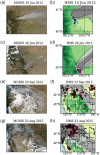Differential Cardiopulmonary Health Impacts of Local and Long-Range Transport of Wildfire Smoke
- PMID: 35281479
- PMCID: PMC8900982
- DOI: 10.1029/2020GH000330
Differential Cardiopulmonary Health Impacts of Local and Long-Range Transport of Wildfire Smoke
Abstract
We estimated cardiopulmonary morbidity and mortality associated with wildfire smoke (WFS) fine particulate matter (PM2.5) in the Front Range of Colorado from 2010 to 2015. To estimate WFS PM2.5, we developed a daily kriged PM2.5 surface at a 15 × 15 km resolution based on the Environmental Protection Agency Air Quality System monitors for the western United States; we subtracted out local seasonal-average PM2.5 of nonsmoky days, identified using satellite-based smoke plume estimates, from the local daily estimated PM2.5 if smoke was identified by National Oceanic and Atmospheric Administration's Hazard Mapping System. We implemented time-stratified case-crossover analyses to estimate the effect of a 10 µg/m3 increase in WFS PM2.5 with cardiopulmonary hospitalizations and deaths using single and distributed lag models for lags 0-5 and distinct annual impacts based on local and long-range smoke during 2012, and long-range transport of smoke in 2015. A 10 µg/m3 increase in WFS was associated with all respiratory, asthma, and chronic obstructive pulmonary disease hospitalizations for lag day 3 and hospitalizations for ischemic heart disease at lag days 2 and 3. Cardiac arrest deaths were associated with WFS PM2.5 at lag day 0. For 2012 local wildfires, asthma hospitalizations had an inverse association with WFS PM2.5 (OR: 0.716, 95% CI: 0.517-0.993), but a positive association with WFS PM2.5 during the 2015 long-range transport event (OR: 1.455, 95% CI: 1.093-1.939). Cardiovascular mortality was associated with the 2012 long-range transport event (OR: 1.478, 95% CI: 1.124-1.944).
Keywords: epidemiology; long‐range transport; morbidity; mortality; smoke; wildfires.
© 2021. The Authors.
Conflict of interest statement
The authors declare no conflicts of interest relevant to this study.
Figures









References
-
- Bertschi, I. , Yokelson, R. J. , Ward, D. E. , Babbitt, R. E. , Susott, R. A. , Goode, J. G. , & Hao, W. M. (2003). Trace gas and particle emissions from fires in large diameter and belowground biomass fuels. Journal of Geophysical Research, 108, 8472. 10.1029/2002JD002100 - DOI
-
- Braga, A. L. F. , Zanobetti, A. , & Schwartz, J. (2001). The lag structure between particulate air pollution and respiratory and cardiovascular deaths in 10 US cities. Journal of Occupational and Environmental Medicine, 43(11), 927–933. - PubMed
-
- Breton, C. , Park, C. , & Wu, J. (2011). Effect of prenatal exposure to wildfire‐generated PM2.5 on birth weight. Epidemiology, 22(1), S66.
LinkOut - more resources
Full Text Sources
